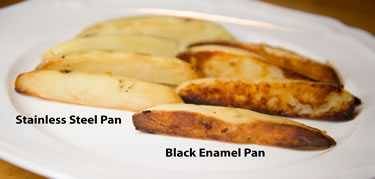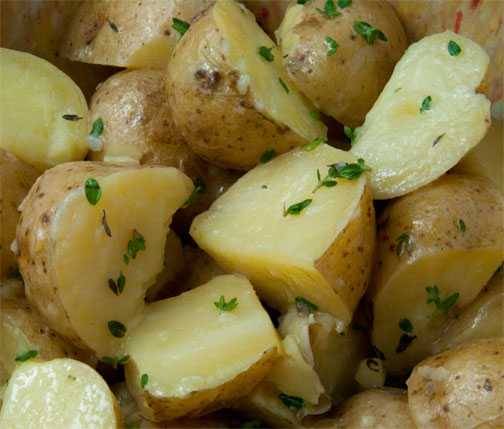So versatile, and such a perfect accompaniment to meat. Such comfortable food.
Despite what you might have heard, potatoes are not from Ireland. Scientists believe they come from the Lake Titicaca, Peru, area, at about 12,500 feet above sea level, where they were first cultivated by Inca Indians 8,000 years ago. The International Potato Center in Lima, founded in 1971, maintains the world’s largest collection of potato seeds: More than 4,500. Spanish conquistadors brought them back to Europe in the 1500s and today they are the world’s fouth most important food source, after wheat, corn, and rice, according to William Roca, a geneticist at the Center.
They grow underground, bulbous parts of the plant’s roots called tubers. The flesh is usually white, but it can also be yellowish, purple, or even red. The skin is not only the familiar tan and brown, but red, purple, blue, pink with yellow spots, and yellow with pink spots, and it gets thicker with age. Loaded with starch and sugars, they get sweeter with age. The skin is usually edible if washed thoroughly, and it should be eaten because many of the nutrients are in the skins or just under them.
The three categories of potatoes
For cooking purposes, potatoes can be divided into three categories:
- Starchy potatoes. These are low in moisture and high in starch, and they are especially good for baking, mashing, frying, and roasting, but they are not very good for boiling because they can disintegrate if boiled too long. When they are cooked their texture is dry and floury. Most common is the Russet Burbank from Idaho. King Edward is another common variety.
- Waxy potatoes. These are good, all-purpose spuds because they have moderate moisture and starch. When boiled they get soft around the edges but hold their shape, making them especially good for potato salads and casseroles. Most red-skinned potatoes are waxy. Yukon Gold is a popular example.
- New potatoes. These are young spuds harvested in late winter and early spring. They are usually small, about golf ball size, thin skinned, and low in moisture and starch. They are best for boiling, skin and all. Use these in stews, soups, or boiled, buttered, and sprinkled with parsley or your favorite herb. Many of the fingerling potatoes are new potatoes.
The all-purpose potato. All this understood, there is one potato that comes close to being the all-purpose spud, good for practically any use, it’s the Yukon Gold. Developed in 1966 at University of Guelph in Canada and released to the public in 1980, they are medium sized with a tan skin and a pale, cream color. They are medium starch and that makes them soft enough for mashing and sturdy enough for stews. In addition to its versatility under a variety of cooking conditions, it has a winning mild buttery flavor. Yukon Golds, hands down, are my faves.
Buying and handling potatoes
Buying potatoes. Try to buy potatoes individually rather than by the bag so you can inspect them. When selecting potatoes, try to pick those that are firm, without sprouts, and with no bruises, scars, or green patches. Greenish potatoes can have a mild toxin, solanine, but in such minute amounts there is nothing to worry about. To be safe, discard any potatoes that have green patches.
Storing potatoes. Potatoes should be stored in the cool and dark, but not frozen. Ideal storage temp is 40-45°F at 95% humidity. Root cellars and crawl spaces are good. In the fridge the starches turn to sugar quicker, and the cold can also darken the meat. Potatoes and onions go together well on the dinner plate, but not in storage. They each emit a gas that can spoil the other. Put them in paper bags, not plastic bags. The need to breathe or they can rot.
Quality control. After you wash them or peel them, sniff them! If they smell moldy or musty, throw them out.
Cleaning potatoes. Potatoes grow underground and come out of the ground covered in dirt. They are cleaned before sold, but there can still be a bit of dirt and microbial contamination, so they need to be scrubbed vigorously. Most cookbooks recommend a brush, but I prefer a scrubby sponge that has no residual soap in it. If you plan to eat the skin, cut out the bad spots, but you can leave in the eyes. Sniff them carefully and discard any that smell musty.
Green, sprouted, or wrinkled potatoes. Fresh firm and properly stored potatoes are safe to eat. As they age, they can develop green spots, the eyes can sprout, they can get wrinkly and soft. When this happens they can develop compounds called glycoalkaloids (GAs) which can be toxic. Most people will be unharmed by small quantities of GAs, but some may react poorly. In addition, the starches may start converting to sugars in these older potatoes. Removing the sprouts and the meat around them will remove toxins. Do not eat potato sprouts. Green spots are harmless chlorophyl, but they can be an indicator of the presence of toxins. As always, when in doubt, throw it out.
The color of the pan matters!
The potatoes below were peeled, lightly coated in oil, and cooked in lightweight baking pans about the same thickness and weight. The potatoes on the left were cooked in a stainless steel pan and the ones on the right were cooked in a steel pan coated with black enamel.

As you can see, the black pan absorbed and transmitted more heat doing a better job of browning the potatoes. That’s why a black car is hotter than a white car on a summer day. Even though there isn’t much visible light in the oven, the radiation from the heat works like light and will not be absorbed as well by a shiny or white pan. Cookie bakers learn that the darker the pan the browner the cookie bottoms, as do pizza bakers.
According to the AmazingRibs.com science advisor Prof. Greg Blonder “Likewise, a clear Pyrex pie plate transmits infrared energy the glass to brown crust a bit more quickly, which is why so many cornbread recipes call for a clear pan. Otherwise a low thermal conductivity Pyrex pan cooks more slowly than a high conductivity aluminum pan (200 times more conductive than glass), or cast iron (50 times more conductive than glass). Other properties impact browning, such as the mass of the pans (if they were preheated) and their position in the oven.”
The secret to great fries?
Listen to what Jerry Murrell, Five Guys Burgers and Fries said about his fries in an interview in Inc. magazine: “Most of our potatoes come from Idaho. We try to get our potatoes grown north of the 42nd parallel, which is a pain in the neck. Potatoes are like oak trees — the slower they grow, the more solid they are. We like northern potatoes, because they grow in the daytime when it is warm, but then they stop at night when it cools down. It would be a lot easier and cheaper if we got a California or Florida potato. Most fast-food restaurants serve dehydrated frozen fries — that’s because if there’s water in the potato, it splashes when it hits the oil. We actually soak our fries in water. When we pre-fry them, the water boils, forcing steam out of the fry, and a seal is formed so that when they get fried a second time, they don’t absorb any oil — and they’re not greasy.” That’s right, many experts believe the best fries are fried but not cooked through, then taken out and rested at room temp, and when ordered, fried a second time.



High quality websites are expensive to run. If you help us, we’ll pay you back bigtime with an ad-free experience and a lot of freebies!
Millions come to AmazingRibs.com every month for high quality tested recipes, tips on technique, science, mythbusting, product reviews, and inspiration. But it is expensive to run a website with more than 2,000 pages and we don’t have a big corporate partner to subsidize us.
Our most important source of sustenance is people who join our Pitmaster Club. But please don’t think of it as a donation. Members get MANY great benefits. We block all third-party ads, we give members free ebooks, magazines, interviews, webinars, more recipes, a monthly sweepstakes with prizes worth up to $2,000, discounts on products, and best of all a community of like-minded cooks free of flame wars. Click below to see all the benefits, take a free 30 day trial, and help keep this site alive.
Post comments and questions below
1) Please try the search box at the top of every page before you ask for help.
2) Try to post your question to the appropriate page.
3) Tell us everything we need to know to help such as the type of cooker and thermometer. Dial thermometers are often off by as much as 50°F so if you are not using a good digital thermometer we probably can’t help you with time and temp questions. Please read this article about thermometers.
4) If you are a member of the Pitmaster Club, your comments login is probably different.
5) Posts with links in them may not appear immediately.
Moderators